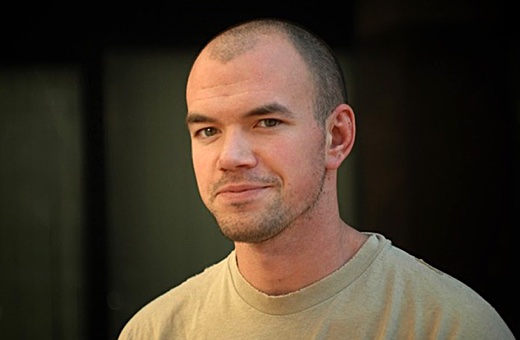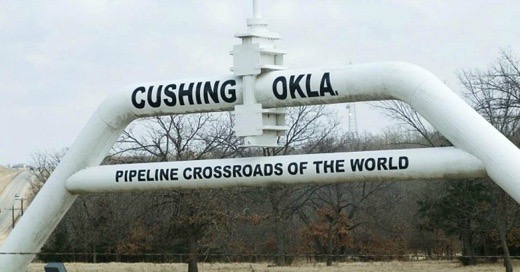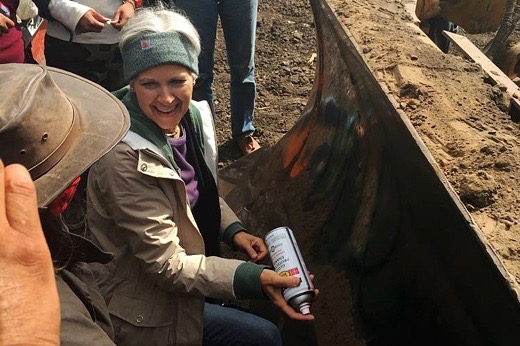SUBHEAD: Tim DeChristopher "We've never seen the government stand up to the fossil fuel industry.
By Dahr Jamail on 24 October 2016 for Truth Out -
(
http://www.truth-out.org/opinion/item/38097-we-ve-never-seen-the-government-stand-up-to-the-fossil-fuel-industry-tim-dechristopher-on-our-climate-future)
 Image above: Photograph of Tim DeChristopher. Taken by Dahr Jamail. From original article.
Image above: Photograph of Tim DeChristopher. Taken by Dahr Jamail. From original article.
In 2008,
Tim DeChristopher found himself bidding for parcels of public land around Arches and Canyonlands National Parks of Utah at an illegitimate Bureau of Land Management oil and gas lease auction.
A climate activist acting as
a bidder at the auction, DeChristopher ended up successfully winning 22,500 acres of land by bidding a total of $1.8 million, which he never intended to pay one nickel of, hence effectively killing the auction.
Taken into custody by federal agents, DeChristopher ended up serving 21 months in prison for his action, despite the US Department of the Interior cancelling many of the leases just after the auction.
His actions thrust him into the national and international media spotlight. DeChristopher co-founded the group
Peaceful Uprising, a climate justice group that describes its task as "working to build an uncompromising movement to defend a livable future," and remains committed to nonviolence while functioning effectively within the most violent society and government on the planet.
The urgency of his work, and that of Peaceful Uprising, could not be more justified.
Earth's atmosphere
recently passed the 400 parts per million threshold of CO2.
According to NASA, 11 of the last 12 months have been the hottest months, respectively, in the 136 years of record keeping. This year is, once again, on track to be another hottest year ever for the planet, beating last year, which was itself the hottest year yet recorded. In fact, 15 of the 16 hottest years ever recorded, globally, have happened since 2000.
This past February, in the dead of winter, a Norwegian Coast Guard icebreaker ship
found no ice to break, despite the fact that it was barely 800 miles from the North Pole. This is devastating, but not surprising: This year, the Arctic summer sea ice tied its second lowest extent on record.
Satellite data now shows a very rapid acceleration in global sea level rise, a rate increase not seen since the end of the last Ice Age -- and it continues to accelerate.
Early this February, atmospheric CO2
reached a level not seen on the planet for more than 2.5 million years.
These levels of CO2, which we are now living with permanently, are bringing Earth to a realm not experienced since the Pliocene epoch, which was the period 2.6 to 5.3 million years ago that saw atmospheric CO2 levels between 350 and 405 parts per million and average global temperatures that ranged between 2 and 3 degrees Celsius warmer than the climate of the 1880s.
At that time, there were even lower CO2 levels in the atmosphere than we have today, and global sea levels were 80 feet higher than they are right now.
In short, we are living in a new world, and the planet is rapidly adjusting to the level of heating we have imposed upon it.
Through this lens, it's clear that the actions of DeChristopher and other activists involved with Peaceful Uprising are both urgent and crucial, given that the US government is completely beholden to the fossil fuel industry.
Earlier this month, in what Reuters described as "
the biggest coordinated move on US energy infrastructure ever undertaken by environmental protesters," activists across four states shut down five tar sands pipelines flowing into the US from Canada, bringing to a full stop the daily ration of 2.8 million gallons of tar sands crude oil.
The government responded in predictably draconian fashion by arresting the activists, supporting personnel and independent filmmakers. They are facing the most serious charges ever leveled at US climate activists: One of the filmmakers is facing up to 45 years in prison if convicted.
Yet, increasing numbers of people are taking up the struggle and joining DeChristopher -- as well as many Indigenous activists like those at Standing Rock -- as the planet burns. The fact that the government continues to overtly side with the fossil fuel industry is only adding fuel to the activists' proverbial fire.
DeChristopher has used his public presence as a platform to spread the message of urgency of the climate crisis along with the need for courageous, directly confrontational civil disobedience. His work is aimed at creating a just and healthy world by halting fossil fuel projects, and continuing to bring attention to the crisis that is upon us.
Truthout recently spoke with DeChristopher about the imperativeness of "moral agency," the difference between the environmental and climate justice movements, and the importance of spiritual resiliency in the face of the prospect of a collapsing civilization.
INTERVIEW BY DAHR JAMAIL
Truthout: Talk about the importance of what you've referred to as "moral agency." We are living in a time when the government is clearly on the side of corporate power, and talking more specifically about climate disruption, government is in the pocket of the fossil fuel industry. For people who are concerned about the planet, and worried about how far along we already are regarding climate disruption, acting from a place of moral agency is going to put them in a position, eventually, where they are squarely confronting the government (local, state, federal). From your experience, and your understanding of the system, why is it more important than ever for people to act from that place of moral agency?
Tim DeChristopher: Folks in positions of power in the government are not adequately addressing the climate crisis. Those of us outside that structure, if we're to address it with integrity and moral agency, we have to confront those in power.
Even [from] those in government [who are] closer to taking action, all we're hearing from them is mild rhetoric and small steps we needed to have taken about 20 years ago.
So they are certainly not up to speed to where we need to be right now, so the task of acting with the sense of urgency necessary is up to ordinary citizens. By and large, the government is still beholden to those corporations beholden to the status quo, which is not something that will provide us with a livable future.
Truthout:"The law is a tool of those in power," you said during an interview on Bill Moyers' program. Talk more about that, from the perspective of the dovetailing of government and the fossil fuel industry.
Tim DeChristopher: Look at what is happening in North Dakota today and over the last few months. This is what it looks like for a government to be acting like a private security force for the fossil fuel industry. Using military force to prevent the Indigenous folks in Standing Rock, and their allies, from standing in the way of a pipeline project.
And when folks do take a stand to shut down all five tar sands pipelines, they are met with a draconian response from the government that is acting on behalf of the fossil fuel industry.
So folks taking one of the boldest steps so far by actively shutting down the pipelines -- they are met with the harshest criminal charges that any climate activist in the US has ever faced for taking a nonviolent direct action.
They are facing up to 80 years in prison, and that is something we've not seen before in this movement. That puts us in a new era of our government acting on behalf of the fossil fuel industry, while activists are acting on behalf of future generations.
Truthout: Given that we are living in a world whose resources are now going to continue to be increasingly restricted and constricted and shrunken by climate disruption, do you think western civilization, as it exists today, will continue? If not, what might it look like in, say, 25 years?
Tim DeChristopher: In terms of this globalist, capitalist, Western-dominated world, I don't see that lasting. It's obvious that this system is mortal. That in and of itself is an idea people like to deny: that this system has always been mortal, but that we're now at a point where we're reaching the final stand of that civilization and that collapse is now pretty imminent.
There is still a huge degree of uncertainty around what that collapse looks like, and it's clear you can't keep living in a world that continues to increase material consumption year after year.
So, we have to be on a fundamentally different path, and there are positive steps in controlling that process of collapse and steering us towards a collapse that still holds onto our humanity and shared values.
We have communities working towards social justice and towards a common good, as opposed to individual greed. Neither of those is inevitable now and activism is so critical on direct climate issues, but also towards the social justice issues that will determine if we turn against each other through fear and greed, or with cooperation, love and mutual support.
Truthout: You're not a fan of the idea that we should work towards the greening of corporate power. You are not hoping to pressure a company like Walmart to become more eco-conscious; rather, you have spoken about having a Walmart that is "subservient to human interests." What would that look like?
Tim DeChristopher: This week's action of the five that shut down the tar sands pipelines is a great example of that. They are not under the illusion that they'll get a company, whose fundamental business model is to destroy our planet, to be on our side.
They [activists] are immediately hurting the bottom lines of those companies that put their product, directly and indirectly, through those pipelines. The activists are putting the government on a line where they have to choose between those companies and the common good of the people.
The immediate aftermath of those actions is the government choosing to stay on the side of industry. But we have seen times when that can't really hold and the government has to back down. And a big part of that is public attention and pressure on the issue. This is why how we support other activists when they are taking bold action is critical.
It remains to be seen if the government continues to follow through all the way and locks the activists up for decades, as they are threatening, or whether the public outcry over that is so great that the government cannot jail them for the decades they are threatening to and still hold onto their power.
This is why those who support the front-line activists and the media telling their story are critical, not only to protect those activists but in terms of the broader goal of shifting the balance of power in our society.
Truthout: What would an appropriate response from the federal government towards the climate crisis look like?
Tim DeChristopher: Many of the plans that have been on the table since before President Obama even took office have addressed this. There were organizations, as well as individuals providing lists, like an economic policy that included a carbon tax, changes in our agricultural system to shift subsidies away from industrial agriculture to food that is actually healthy for people and the planet, to steps that revolutionize our transportation system and invest in public transportation in both urban and rural areas to get us away from our car culture.
All those plans have been on the table for quite some time.
But the only stances the government takes are consistently consumer- and demand-oriented. We've never seen the government stand up to the fossil fuel industry.
Not just the government, but the executive office of the presidency itself has control over fossil fuel leases on public lands, so Obama could keep those fossil fuels in the ground, and that's just a bare minimum to address the climate crisis to meet the Paris agreements.
But unfortunately, we've seen the opposite during the Obama presidency ... the opening of the Powder River Basin to new coal development, an amount of coal that alone vastly outweighs the consumer measures he's taken. He's also opened huge new areas of the Gulf of Mexico and Atlantic Coast to new drilling.
Truthout: What is the difference between the climate justice movement, and the environmental movement?
Tim DeChristopher: Largely it's a matter of opinion. But the environmental movement has been fading out over the last 15 to 20 years and is now pretty marginal.
The environmental movement, what's left of it today, addresses largely localized issues -- issues of land protection and toxic pollution, for example -- whereas the climate justice movement is taking a larger, more holistic view of global problems, and while it addresses those on local levels along with the human impact of these issues, it looks at the bigger picture of how all of these things are connected.
A lot of the tools we use to fight climate justice battles, like the Endangered Species Act, are still used to defend areas and stop fossil fuel projects, but they [are] ultimately too narrow in scope to address the climate crisis.
Truthout: What are the strengths of the climate justice movement?
Tim DeChristopher: It is [a] holistic view, and this extends beyond environmental issues to where those are connected to all of the social justice issues.
The climate justice movement has helped build working relationships with organizations and movements that are addressing immigrant and labor and LGBT rights, and [it is] not only building allies and relationships, but addressing how all of these issues are fundamentally interconnected.
We are helping our allies with each of their battles while viewing it through the lens of climate change. There's been a tremendous amount of progress on that, but there is a lot of baggage to overcome through the roots of the environmental movement, which was a mostly white, upper middle class movement.
Truthout: Weaknesses?
Tim DeChristopher: There is a lot of progress to be made. The biggest weakness is the tendency towards self-righteousness. We've moved beyond where the environmental movement used to be, and now see how interconnected all the various movements are.
But there is a tendency to shame and call out those who are one step behind us and congratulate ourselves, and there's not much room for growth and progress when this happens.
Truthout: What does a strong, vibrant, heavily populated, powerful, and most importantly, effective climate justice movement look like?
Tim DeChristopher: It is constantly developing and changing, like the crisis itself. We're learning more and more about the threats and the ways in which our opponents are trying to maintain the status quo, yet we need to be constantly innovating and challenging our old assumptions and constantly exploring new territory.
This recent tar sands shutdown is new territory for our movement, and [for] the activists who entered into this bold unknown territory of higher risk and more confrontation by targeting this essential infrastructure.
All these new steps forward need to be supported and encouraged, even the ones that don't work out.
We need to see more of these actions that take us into new territories, and an increase and expansion of these types of actions.
But there is also a need for an increase and expansion of a lot of the other actions in the movement. We've seen some real steps towards electoral involvement, like via the Bernie Sanders movement. This needs to be expanded as well.
And things like building community solar needs to be ramped up, for example. It's not that everybody needs to be doing just one of these, but all of these at the same time, as a movement, and we need to be putting more resources into all of these efforts.
Truthout: Are you seeing a movement of climate activists that is approaching critical mass?
Tim DeChristopher: I don't know. Where would that critical mass be? I wonder. It's hard to judge exactly where that tipping point is. We could be close to it, and a few more people in the movement could get us there, but we're in unprecedented territory now. It's hard to say where that tipping point is going to be. We just know need more people acting more boldly and taking more initiative and being more creative.
Truthout: Are you optimistic about climate activism in the US?
Tim DeChristopher: I wouldn't say that I'm optimistic. We've gotten a lot deeper in our movement in the past few years alone. Not only in terms of a deeper understanding of justice and an intersectional analysis, but a deeper spiritual understanding within the movement as well.
A lot more people are recognizing the need to be spiritually grounded when we do this work.
More and more folks understand that it is now too late to stop the climate crisis, and we are headed towards some sort of collapse. We need to be able to handle that in a way we never have before. We need a spiritual resiliency and a different foundation for meaning than we've had before.
We've found more people willing to have that conversation and explore that territory. That holds a lot of promise -- not that things are going to be okay and we're going to overcome our social evils and have a green utopia forever, but that we are going to be able to continue the struggle.
We still have all the way to go. The struggle will always be with us, all the interconnected struggles against our social ills, and we're not going to
solve racism and patriarchy and classism, but we can learn and grow and make positive steps forward, while knowing that we will always have more steps to take.
.







